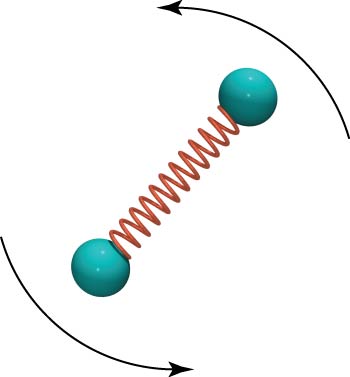Example: The Moment of Inertia of a Diatomic Molecule
What is the moment of inertia of a diatomic nitrogen molecule $N_{2}$ around its center of mass. The mass of a nitrogen atom is $2.3$ x $10^{-26}$ kg and the average distance between nuclei is $1.5$ x $10^{-10}$ m. Use the definition of moment of inertia carefully.
Facts
Mass of nitrogen atom is 2.3 x $10^{-26}$kg
Average distance between nuclei is 1.5 x $10^{-10}$m
Assumptions and Approximations
The distance between the atoms in the molecule does not change.
The model of the system you are using includes a spring between the atoms but these are not actual springs so the spring has no mass.
Lacking
The moment of inertia of a diatomic nitrogen molecule $N_{2}$ around its center of mass?
Representations
Solution
For two masses, $I = m_{1}r^{2}_{\perp1}$ + $m_{2}r^{2}_{\perp2}$.
The distance between the masses is d, so the distance of each object from the center of mass is $r_{\perp1} = r_{\perp2} = d/2$.
Therefore:
$I = M(d/2)^{2} + M(d/2)^{2} = 2M(d/2)^{2}$
Where you substitute in M for $m_{1}$ and $m_{2}$ as it is the same total mass we are talking about.
Substitute in given values for variables.
$I = 2 \cdot (2.3$ x $10^{-26}kg)(0.75$ x $10^{-10}m)^2$
Compute moment of inertia of diatomic nitrogen molecule
$I = 2.6$ x $10^{-46} kg \cdot m^2$
